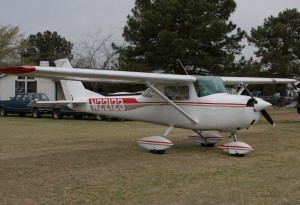 All the students of USAF Undergraduate Pilot Training (UPT) Class 66-D at Reese AFB, Texas, had private pilot’s licenses obtained with civilian instructors. The airplanes we flew had only one internal combustion engine (just like in your car) and a propeller. In that initial training, instructors had the nasty habit of surprising us with simulated engine failure.
All the students of USAF Undergraduate Pilot Training (UPT) Class 66-D at Reese AFB, Texas, had private pilot’s licenses obtained with civilian instructors. The airplanes we flew had only one internal combustion engine (just like in your car) and a propeller. In that initial training, instructors had the nasty habit of surprising us with simulated engine failure.
Picture yourself flying along concentrating on a maneuver and suddenly this hand from out of nowhere shoves yours off the throttle and pulls it back to idle. Drag is now way more than thrust. If you try to hold altitude, you will slow down and ultimately stall the airplane when the wing exceeds critical “angle of attack.” You know this, of course, intrepid fledgling aviator that you are, and you allow the airplane to slow only to “best glide” airspeed before you begin a descent, trading altitude for time to find a place to land.
 If the instructor pulled his little surprise in the airport traffic pattern, you would continue the maneuver all the way to touchdown on the runway. But sometimes, the instructor would do this out in the practice area, which tests your ability to maintain aircraft control, analyze the situation and take proper action (which didn’t mean getting into a fistfight with the instructor over control of the throttle) by checking ignition and fuel (which you were then told to assume hadn’t fixed the problem). Okay, you’re now flying a glider, and it’s time to find a road or open area that might allow you to land and survive it. While still at a safe altitude and able to assess whether you could have made the chosen landing zone, the instructor would “give the throttle back” to you and terminate the maneuver.
If the instructor pulled his little surprise in the airport traffic pattern, you would continue the maneuver all the way to touchdown on the runway. But sometimes, the instructor would do this out in the practice area, which tests your ability to maintain aircraft control, analyze the situation and take proper action (which didn’t mean getting into a fistfight with the instructor over control of the throttle) by checking ignition and fuel (which you were then told to assume hadn’t fixed the problem). Okay, you’re now flying a glider, and it’s time to find a road or open area that might allow you to land and survive it. While still at a safe altitude and able to assess whether you could have made the chosen landing zone, the instructor would “give the throttle back” to you and terminate the maneuver.
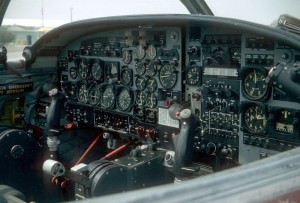 But the T-37 had two jet engines, so UPT instructor pilots (IPs) only pulled one throttle to idle. At altitude that’s no biggie, because unlike most light twin-engine civilian airplanes, a T-37 on one engine could do more than “get you to the scene of the crash” (the standard joke about the benefit of having a second engine). But the instructor knew that, of course, bold military aviator that he was, so he waited until you didn’t have much altitude (or airspeed) before snatching a throttle to idle, and you’d better have a pretty good idea what to do about it.
But the T-37 had two jet engines, so UPT instructor pilots (IPs) only pulled one throttle to idle. At altitude that’s no biggie, because unlike most light twin-engine civilian airplanes, a T-37 on one engine could do more than “get you to the scene of the crash” (the standard joke about the benefit of having a second engine). But the instructor knew that, of course, bold military aviator that he was, so he waited until you didn’t have much altitude (or airspeed) before snatching a throttle to idle, and you’d better have a pretty good idea what to do about it.
The emergency procedure for single-engine failure is a “bold face,” or “commit to memory” item, and we got a lot of practice dealing with single-engine landings and “go-arounds,” in which we had to reject the landing with only one engine operating. IPs would come up with some reason, like, “There’s an airplane on the runway. Go around!” to test our ability to do that safely. It’s a critical skill with the potential for deadly consequences if not mastered. Here’s why:
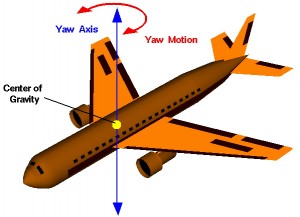 The acronym VMC stands for “velocity (or airspeed), minimum control.” Although non-flyers might consider this illogical, “control” in this instance refers to the pilot’s ability to maintain the direction of the aircraft within safe parameters. In aviator’s terms, we call this yaw, defined as rotation of the aircraft around the yaw axis, an imaginary line drawn vertically through the fuselage of the aircraft at the center of gravity. The rudders moved by the pilot’s feet provide yaw control. Push on a rudder pedal with either foot and the nose of the aircraft will yaw in that direction. (Illustration courtesy NASA)
The acronym VMC stands for “velocity (or airspeed), minimum control.” Although non-flyers might consider this illogical, “control” in this instance refers to the pilot’s ability to maintain the direction of the aircraft within safe parameters. In aviator’s terms, we call this yaw, defined as rotation of the aircraft around the yaw axis, an imaginary line drawn vertically through the fuselage of the aircraft at the center of gravity. The rudders moved by the pilot’s feet provide yaw control. Push on a rudder pedal with either foot and the nose of the aircraft will yaw in that direction. (Illustration courtesy NASA)
So how is yaw a factor when dealing with one engine failure on a twin-engine airplane? I’m glad you asked.
Consider a typical arrangement with the engines mounted on the wings. If both engines are operating at the same power setting, little or no yaw is produced because equal thrust is acting on the aircraft from both sides. If we evaluate what happens when one engine suddenly fails, we find that three factors combine to create a serious problem.
If the left engine fails, it’s no longer producing thrust and in fact can add significant drag. Think of it as pulling the left wing backwards. The right engine, meanwhile, is still producing thrust, which shoves the right wing forward. This is classic yaw due to asymmetrical thrust. It rotates the aircraft around the vertical axis, the nose yaws left, and the pilot is suddenly faced with the requirement to “keep the pointy end of the aircraft forward.” Unfortunately, the yaw also creates another problem.
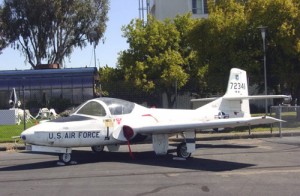 At the moment the left wing moves aft and the right wing moves forward, the left wing loses lift as the right wing gains it. Asymmetric lift on the wings causes the aircraft to roll into a bank. In this case, the left wing drops as the right wing rises, known as “roll due to yaw.”
At the moment the left wing moves aft and the right wing moves forward, the left wing loses lift as the right wing gains it. Asymmetric lift on the wings causes the aircraft to roll into a bank. In this case, the left wing drops as the right wing rises, known as “roll due to yaw.”
The combined result is that as the left engine fails, the aircraft yaws left and rolls into a left bank, both of which create in that instant an out-of-control condition because the aircraft has just done something the pilot didn’t tell it to. This requires immediate application of right rudder to bring the nose back where it belongs, and use of the ailerons to level the wings and keep them there.
Pilots learn through academic knowledge and inflight practice that the combined problem begins with uncommanded yaw due to asymmetric thrust. Control the yaw and the aircraft won’t roll into a bank, which finally brings us back to the subject of VMC.
In a nutshell, at airspeeds below VMC, the pilot cannot command enough rudder authority to keep the nose pointed straight ahead, which means the aircraft will roll into a bank. The pilot has just become a passenger. In case you were wondering, that’s not good.
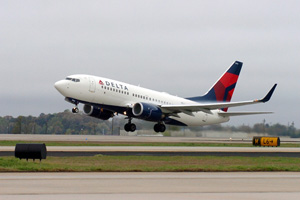 Takeoff is the most critical flight condition in relation to engine failure, when the aircraft typically weighs the most and both engines are at full power. If the sudden loss of thrust on one side occurs when the aircraft is below VMC, the pilot cannot maintain directional control unless power is reduced on the operating engine.
Takeoff is the most critical flight condition in relation to engine failure, when the aircraft typically weighs the most and both engines are at full power. If the sudden loss of thrust on one side occurs when the aircraft is below VMC, the pilot cannot maintain directional control unless power is reduced on the operating engine.
Which is exactly why the emergency procedure for engine failure below VMC calls for THROTTLES – IDLE as a first step. Abort the takeoff and try again another day.
Depending on factors too numerous to cover here, an abort may be appropriate for an engine failure after VMC, but the pilot knows that to continue the takeoff on one engine is an option only if the airspeed is at or above VMC.
The next most critical engine-out flight condition is rejecting a landing attempt. Flying the airplane on final approach to the runway is generally no problem because the operating engine at low-to-mid power settings can maintain airspeed at VMC plus a safety factor during both the descent and level flight portions of the approach. This ensures that applying full power for a go-around will not create more yaw than the rudder can handle. Uncontrollable yaw and roll low to the ground are deadly, and the most serious mistake a pilot can make on an engine-out approach is to slow below VMC prior to landing assured.
Reference the above tail-on view of a T-37, yaw due to asymmetric thrust is reduced in the T-37 because the engines are not mounted on the wings, but within the fuselage. That said, IPs seemed to really enjoy commanding a go-around at the most inconvenient times. I became very proficient in “uncaging” one of my eyeballs to pay close attention to the airspeed indicator on simulated engine-out approaches.
As the common aviator’s saying goes, I learned about flying from that.

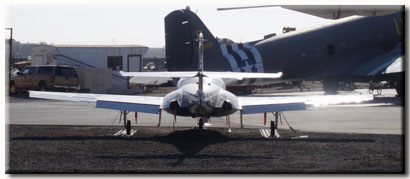


2 Responses to Undergraduate Pilot Training – When an Engine Says, “I Quit”